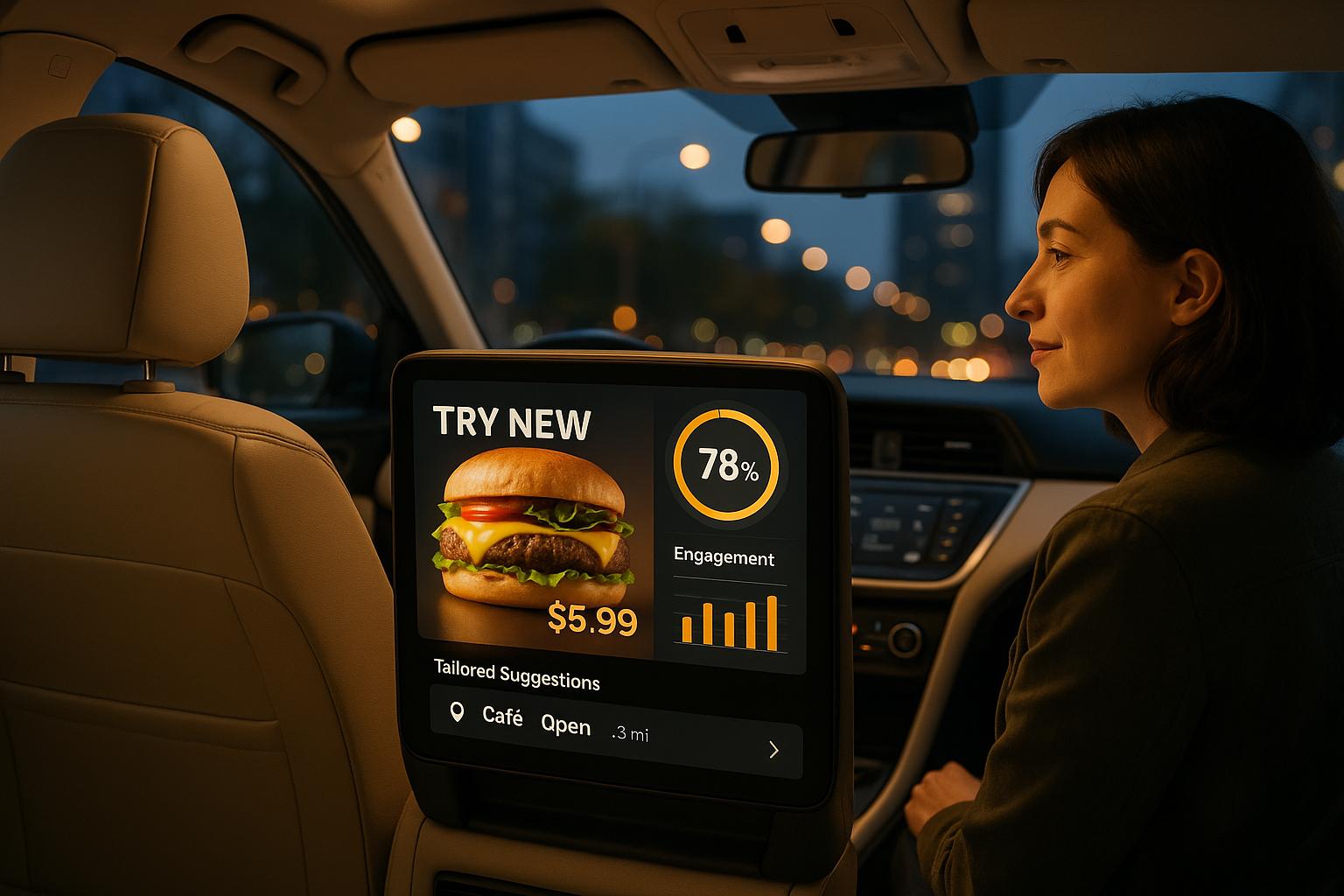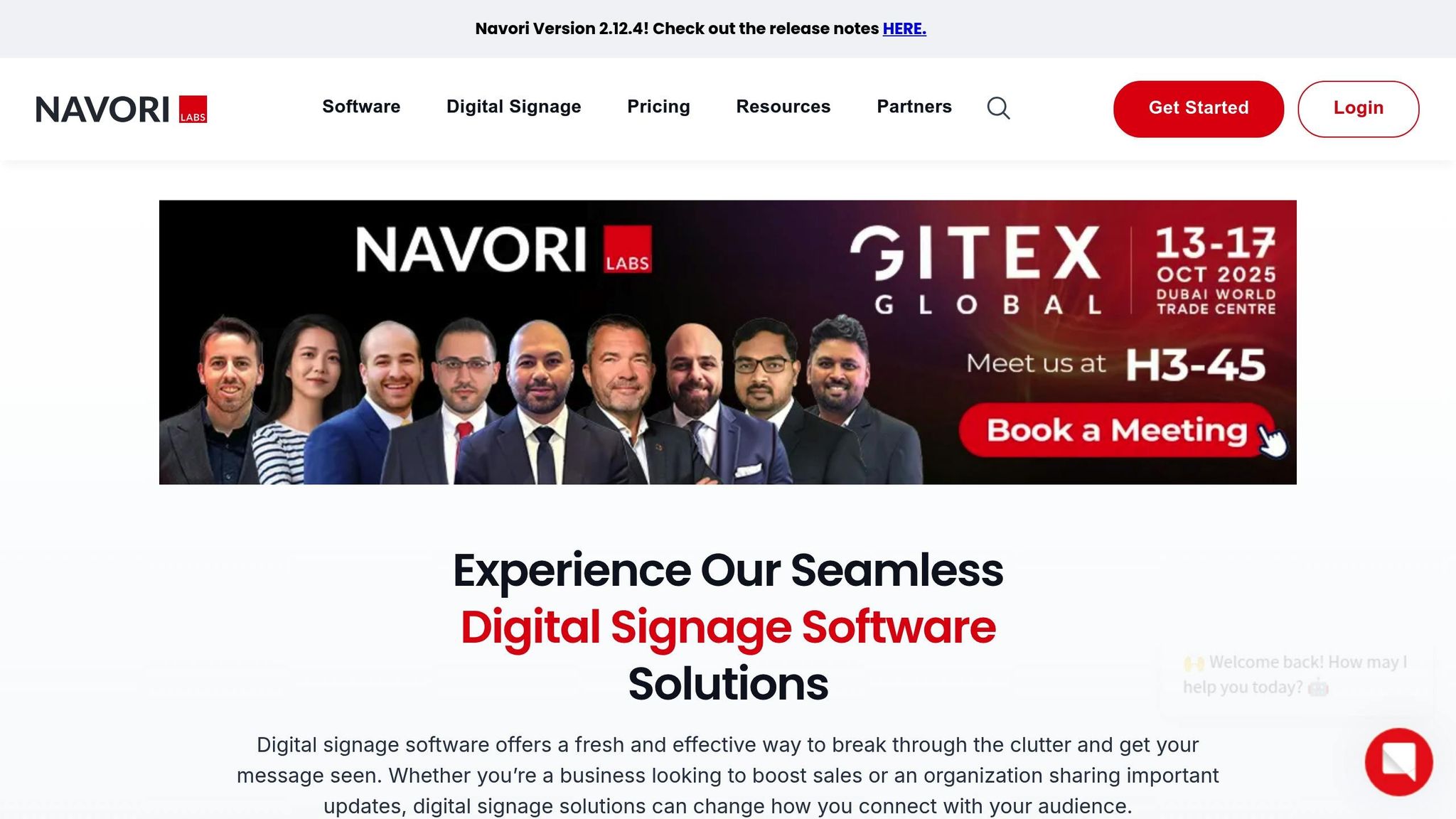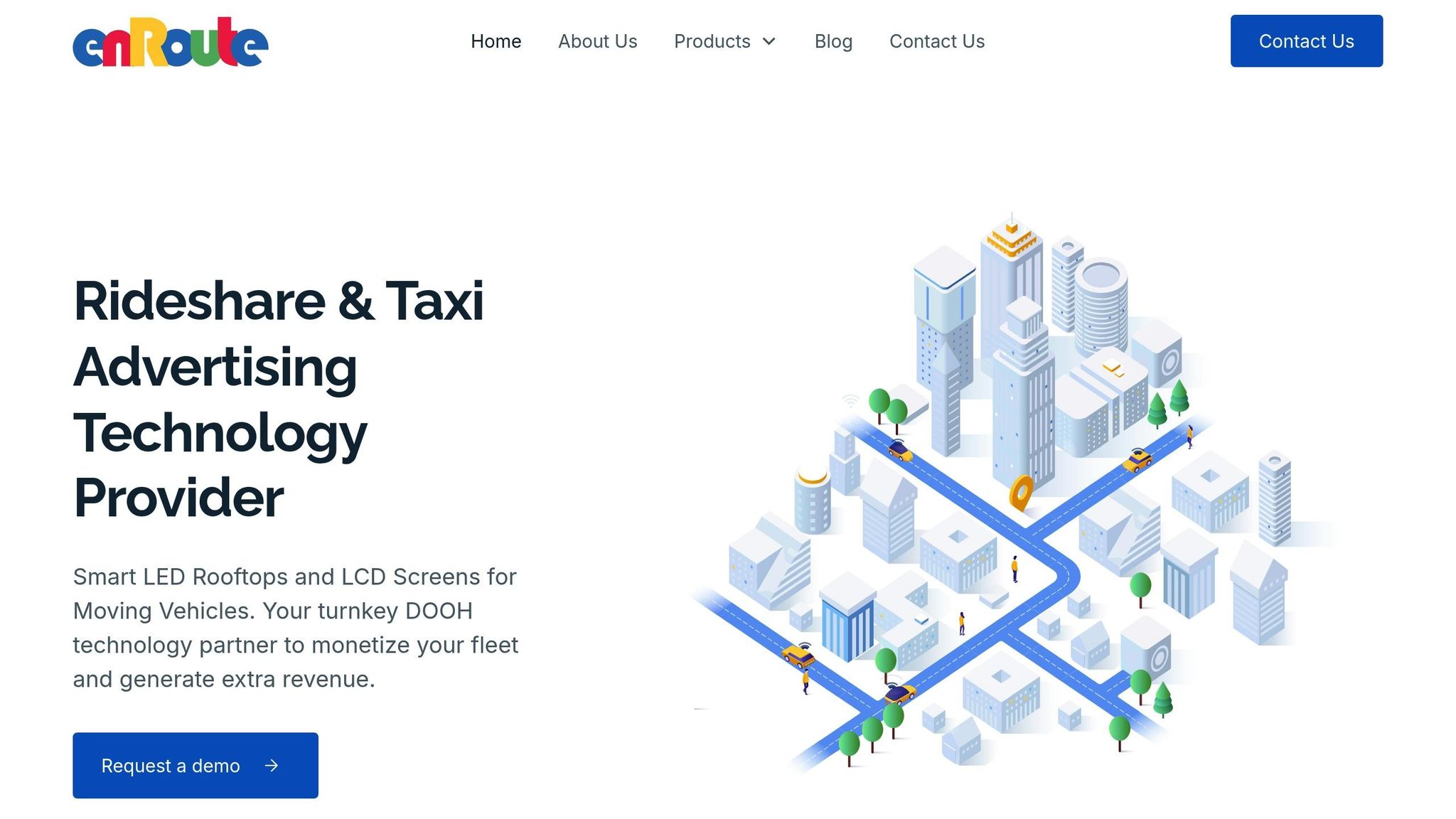Explore how passenger analytics is transforming in-taxi advertising through targeted, real-time data insights for enhanced engagement and effectiveness.

Passenger analytics is reshaping in-taxi advertising by using data to understand how passengers engage with ads during rides. This approach tracks interactions like screen touches, viewing durations, and location-based behavior, enabling advertisers to deliver more targeted, timely, and effective campaigns. Here's what you need to know:
Tools like Enroute View Media's platform integrate real-time data with programmatic ad networks, making in-taxi ads smarter and more impactful. As AI, 5G, and advanced sensors evolve, this space will continue to grow, offering advertisers more precise ways to connect with audiences while prioritizing data privacy.

Knowing where data starts is key to good passenger stats. In-taxi ad setups use many types of data to fully see how passengers react to ads. Each source helps make ad plans better, and together, they give a clearer view of how passengers act.
Tablets in taxis catch every touch, swipe, and scroll by a passenger. These moves show not just what catches their eye, but also how long they look at certain ads or places. For example, how long someone stays on a part - called dwell time - can show what interests them most.
Motion sensors give more clues. Sensors in the tablet can tell if it’s picked up or moved, a sign of active looking. If it's left still, the passenger might just be lightly looking. For instance, a quick tap on a coffee shop ad with no other moves might mean brief interest. But if they grab the tablet and scroll, they're likely more into what they see.
GPS in taxis is great for making ads fit the place. It can set virtual lines around spots like malls or airports. When a taxi moves into these lines, it can show ads for shops or services near there.
Place and time link up. Time marks and GPS details make ad timing better, like showing lunch deals at noon or fun things in the evening. Longer rides to airports can show detailed ads, whereas short city rides might need quick, catchy ones.
Handling this data means big tasks. Firms must follow privacy rules like the California Consumer Privacy Act (CCPA), which makes them tell users what data they take and lets users say no.
To stay safe, data gathering should be minimal - just what’s needed for ads. For instance, only tracking location when the service is used, and using rough place details can balance between personal touches and keeping things private.
A PEW Research Center study found that over half of Americans avoid using products they believe compromise their privacy.
Things like making data safe both when it moves and when it sits still, using many checks before entry, and letting only some people in are key. Firms must also have a good plan ready for fast fixes if breaks happen, telling all who are hit and those in charge.
As rules shift, with groups like the FTC checking how data is used in cars that connect, smart businesses are setting up firm privacy guards from the start. These moves not only meet rules but also grow trust, setting up a base for good ads plans.
Rider stats turn basic data into key clues, giving ad folks a deeper look into how folks in taxis deal with ads. It's more than just counting how many see the ad; these numbers show what grabs attention. With this info, one can make quick changes and see how well an ad works.
Ad folks can use these numbers to make ads work better. Quick tracking means fast changes - if touching ads drops, a new twist in the ad might keep it strong.
Ways folks act, like where and when they get a taxi, give clues for better audience splitting. This info can guide ads to better match different rider groups.
Place tuning is another big move. By using place data, ads can fit the local scene, making it more spot-on for riders.
Timing counts too. Time-tweaks let ads hit when more folks might watch, lifting its power.
Also, keeping ads new is key. Swapping creative based on how numbers look helps keep ads fresh and engaging.
In the end, the aim is to link taxi stats to clear biz gains. Numbers like ad spend return give a sharp view of the money perks from tweaking ads.
Today's smart ad methods let us give very focused ads in no time, using deep data on people who move about. By looking at info like where they are, what they do, and when, clever aiming turns simple data into ads that seem just right and come at the best time. Let's see how place and time help fix up ad sending.
With exact place data, sellers can make ads fit local happenings. For instance, a cab in a busy money area in the morning might show ads for coffee places or work apps. Or, a cab in a cool place at night might push food spots or fun places. Tests find that riders react in ways tied to where and when they are.
Time tips use our normal ways of life. Mornings are great for ads on fast breakfast picks, while nights might aim at food or fun. Even cold or warm days change how well ads work. A cold day might lead to ads for hot drinks or warm clothes.
Aiming along the route adds more exact aim. A ride from a house area to the airport might hint the rider likes travel help, while going from work places to malls might mean they want to shop or relax. Traffic info also helps - if rides are long, you can show more detailed ads; short trips need fast, strong messages.
Plans driven by events also work well. Busy spots like show halls or game fields make it easy to guess rider flow. Like, after a show, a cab could run ads for late snacks, shared rides lower in cost, or close-by fun spots.
Ads don't always work the same, and quick changes make sure plans keep working good. If some ad doesn’t hit well, the system shifts styles or changes how often the ad shows, using live data. Holding off on ads is key - food spots can stop ads when full, while shops might show more ads when it’s slow.
Making many plans work together means a fair system for all sellers. The system puts the best-performing plans first, giving them top spots while pulling back on others that don't do as well. This smart plan makes both interest and space use better.
Things like weather and traffic also help shape plans. Rainy days might bring ads for indoor stuff, while jammed roads might let ads run longer, making for deep stories. Local happenings and road reports help in these changes, setting up even better aiming ways.
AI lifts knowing rider patterns to a higher place by seeing small trends in what they do. For example, riders into fitness ads on Monday might like health stuff more later in the week. This knowledge lets sellers build ad sets that grow interest as time goes on.
Predictive modeling sees what passengers may need. By looking at where and when they get picked up, the system guesses if a passenger is likely on a work trip, with family, or touring, and changes ad stuff to fit.
Natural language handling (NLP) adds more by checking passenger comments and reviews to judge feelings. This fine-tunes ad timing and how often they show, making them feel helpful, not in the way.
Computer vision tech, if it fits with privacy rules, looks at how passengers move and watch. This info helps work out which ad forms work best, forming plans for later ad work.
Automated A/B testing makes ads hit better by testing different ad types and using the ones that do best. This ongoing learning makes campaigns work better as time goes on.
Real-time bidding, using AI, sets ad prices on the go. Top spots in busy times cost more, while slow times are cheaper. This way to set prices helps meet money goals and keeps advertisers happy, making strong ties for the long run.

Enroute View Media's DigiStreamView platform takes raw passenger data and turns it into actionable insights for both advertisers and fleet operators. By analyzing touch interactions and location patterns, the system provides a detailed view of how passengers engage with content during their rides.
Using advanced sensing technology, the platform tracks passenger views on rooftop LED screens and in-vehicle displays, delivering a precise measure of engagement throughout the ride. Fleet operators can access real-time campaign data through a secure white-label portal, which includes performance metrics, detailed reporting, and system integration tools.
The setup features 10.1″ touch-screen Android tablets that collect interaction data whenever passengers engage with ad content. This creates a feedback loop between passenger behavior and location data, identifying where and when engagement happens - whether during morning commutes in business hubs or evening rides through entertainment districts. These real-time insights integrate seamlessly into programmatic ad networks, enabling smarter targeting and revenue optimization.
Enroute View Media connects advertisers to programmatic ad networks, allowing for automated, real-time purchases of taxi ad space. This integration brings in additional ad inventory from global advertisers. Automated bidding systems match available ad slots with the highest-paying advertisers, dynamically adjusting pricing based on factors like demand, location, and time of day.
By managing ad serving, tracking, and reporting, the system removes the complexity for fleet operators. This allows them to focus on operations without juggling multiple advertiser relationships. Designed to serve diverse markets, these tools are tailored to meet the specific demands of the U.S. taxi and rideshare industry.
Enroute View Media has developed features specifically for the large and varied U.S. taxi and ridesharing market. The platform’s geo-time targeting is particularly effective in major American cities, where passenger behaviors shift significantly by neighborhood and time of day.
"Our mission at enRoute View Media is to transform the way brands communicate with consumers in urban environments. By leveraging the latest technology in digital displays and data-driven insights, we are able to offer advertisers a highly effective medium that seamlessly integrates with cityscapes, reaching consumers where they live, work, and play."
- Souhail Alavi, President, enRoute View Media
The platform also addresses regulatory challenges across various U.S. jurisdictions, such as driver distraction and data privacy requirements. With North America accounting for over 37% of the global in-cabin digital signage market, fleet operators benefit from features like customizable CPM rates tailored to local market conditions, multi-language support for diverse urban populations, and white-labeled solutions that preserve their branding while integrating digital advertising.
As we delve deeper into passenger data collection, it's clear there are several technical hurdles and practical strategies that fleet operators and advertisers need to tackle. From ensuring sensor accuracy to maintaining data connectivity and adhering to privacy laws, overcoming these challenges is key to running successful taxi advertising campaigns.
Keeping sensor data accurate is no small feat. Sensors face constant wear and tear from vibrations, environmental factors like sunlight glare, and heavy traffic conditions. Regular sensor calibration is a must to counteract these issues. Simple measures, such as using protective screen covers or tweaking sensitivity settings, can go a long way in preserving data accuracy. For instance, vibrations from stop-and-go traffic might cause false motion readings, so adjusting sensitivity to match driving conditions is crucial.
Data connectivity is another common issue. When connections drop, storing data locally until the system reconnects ensures nothing is lost. Automatic backup protocols can further safeguard data, keeping the system running smoothly even during outages.
Addressing these issues upfront and investing in continuous monitoring and testing ensures campaigns stay on track and deliver reliable results.
To get the most out of passenger analytics, operators should focus on continuous monitoring and structured testing. Tracking key performance indicators (KPIs) allows for quick adjustments to campaigns. For example, testing different ad designs, placement times, or interactive features during a trial period can reveal what resonates best with passengers, enabling fine-tuned strategies.
Transparency in data handling is just as important. Passengers are more likely to cooperate when they know what data is being collected and why. Providing clear privacy notices that explain data usage and offer opt-out options builds trust and improves data quality.
Another key practice is setting performance benchmarks tailored to specific routes. Regularly auditing analytics against operational records can help identify any discrepancies or technical issues before they affect campaign outcomes. Exploring various analytics methods also helps refine strategies for maximum impact.
Each analytics method offers its own strengths. Touch-screen tracking provides detailed insights into passenger interactions, while motion sensors are a more budget-friendly way to gauge presence. Location-based analytics, on the other hand, allows for precise geo-targeting with minimal privacy concerns. Combining these methods gives operators a well-rounded view of passenger engagement, making it easier to adapt advertising strategies to different goals and budgets.
Passenger analytics has transformed in-taxi advertising into a data-driven powerhouse. By leveraging touch, motion, and location data, advertisers now gain actionable insights that were unimaginable just a few years ago.
With real-time optimization, in-taxi campaigns can adapt instantly based on passenger engagement, timing, and location. This agility boosts engagement rates and delivers better returns for advertisers, making every ad placement more impactful.
Transparent data practices, coupled with clear opt-out options, play a crucial role in building passenger trust. Striking the right balance between detailed analytics and respecting passenger privacy will remain a key focus for the industry as it continues to evolve.
By integrating touch-screen, motion, and location analytics, advertisers can create detailed passenger profiles. These profiles enable highly targeted and effective ad campaigns, ensuring the right message reaches the right audience at the right time.
Enroute View Media is well-prepared to capitalize on these advancements, using its platform to drive future success. As new technologies emerge, the landscape of in-taxi advertising will continue to be reshaped in exciting ways.
The future of passenger analytics is packed with potential, thanks to several emerging technologies that promise to take in-taxi advertising to the next level:
As these trends unfold, the in-taxi advertising industry is poised for a future where technology and passenger insights drive more personalized, engaging, and effective campaigns.
In-taxi advertising becomes far more effective with the help of passenger analytics, which enables the delivery of targeted and personalized ads based on real-time passenger insights. This method ensures that the advertisements align with the interests of the audience, leading to greater engagement and better recall. Research even highlights that a notable number of passengers remember ads they see in taxis and are often motivated to make purchases as a result.
By using tools like AI and data analytics, advertisers can customize their messages to align with passenger demographics, preferences, and behaviors. This approach not only makes the ads more relevant but also increases response rates and enhances the overall success of campaigns, ensuring a stronger return on investment.
Passenger privacy and data security are protected through a range of stringent measures. Information is encrypted to block unauthorized access, and all systems adhere to regulations such as GDPR and CCPA. To further protect sensitive data, strict access controls and well-defined incident response protocols are implemented.
Other safeguards include GPS tracking protection, advanced fraud detection systems, and, in some instances, biometric authentication. These efforts not only keep passenger data secure but also support precise and efficient in-taxi advertising.
In taxis, real-time data and AI join forces to create personalized, context-aware ads. By examining details like passenger behavior, trip information, and factors such as location and time of day, these technologies ensure that ads hit the mark at just the right moment.
AI takes it a step further by constantly fine-tuning ad campaigns. It adapts content based on live passenger interactions and trip-specific data. This flexible approach boosts engagement, making in-taxi advertising more impactful for both advertisers and riders.
Need pricing details?